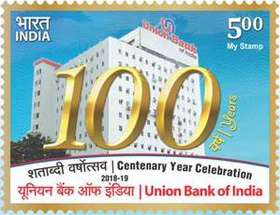Union Bank of India
Union Bank of India (UBI; BSE: 532477) is one of the largest government-owned banks of India with 120+ million customers and a total business of US$106 billion[1]. After the amalgamation with Corporation Bank and Andhra Bank, which came into effect on 1 April 2020, the amalgamated entity becomes the fourth largest bank in terms of branch network and fifth largest in terms of business. UBI now has around 9500 branches after the amalgamation. Four of these are overseas in Hong Kong, Dubai, Antwerp, and Sydney. UBI also has representative offices at Shanghai, Beijing and Abu Dhabi. Lastly, UBI operates in the United Kingdom through its wholly owned subsidiary, Union Bank of India (UK). Union Bank of India was the anchor bank for both Andhra Bank and Corporation Bank, which came into effect on 1 April 2020 as announced by finance Minister of India Nirmala Sitharaman.
 | |
| Public | |
| Traded as | BSE: 532477 NSE: UNIONBANK |
| Industry | Banking, financial services |
| Founded | 11 November 1919 |
| Headquarters | Mumbai |
Number of locations | 9500+ (2020) |
Key people | Shri Rajkiran Rai G. (MD & CEO) Gopal Singh Gusain & Manas Ranjan Biswal (EDs) |
| Products | Consumer banking, corporate banking, finance and insurance, investment banking, mortgage loans, private banking, wealth management |
| Revenue | |
| Total assets | |
| Owner | Government of India (89.07%) |
Number of employees | 75000+ (2020) |
| Capital ratio | 12.81% |
| Website | www |
History
Union Bank of India (Union Bank) was registered on 11 November 1919 as a limited company in Mumbai and was inaugurated by Mahatma Gandhi. At the time of India's independence in 1947, Union Bank of India had four branches – three in Mumbai and one in Saurashtra, in trade centres.[2] By the time the Indian government nationalized Union Bank of India in 1969, it had 240 branches. In 1975, Union Bank of India acquired Belgaum Bank, a private sector bank established in 1930 that had itself merged in a bank in 1964, the Shri Jadeya Shankarling Bank (Bijapur; incorporated on 10 May 1948). Then in 1985 Union Bank of India acquired Miraj State Bank, which had been established in 1929, and which had 26 branches.
Union Bank expanded internationally in 2007 with the opening of offices in Abu Dhabi, United Arab Emirates, and Shanghai in the People's Republic of China.[3] The next year, Union Bank established a branch in Hong Kong, its first branch outside India. In 2009, Union Bank opened a representative office in Sydney, Australia.[4]
On 30 August 2019, Finance Minister Nirmala Sitharaman announced that Andhra Bank and Corporation Bank would be merged into Union Bank of India. The proposed merger would make Union Bank the fifth largest public sector bank in the country with assets of ₹14.59 lakh crore (US$200 billion) and 9,609 branches.[5][6] The Board of Directors of Andhra Bank approved the merger on 13 September.[7][8]
 A 2018 stamp dedicated to the 100th anniversary of the Union Bank of India
A 2018 stamp dedicated to the 100th anniversary of the Union Bank of India
Shareholding
| Shareholders (as on 31-March-2020)[1] | Shareholding % |
|---|---|
| Govt of India | 86.75% |
| FIIs | 1.28% |
| DIIs | 6.37% |
| Public & Others | 5.60% |
Subsidiaries
- Union Bank of India (UK) Limited
- Union Asset Management Co. Private Limited
- Union Trustee Co. Pvt. Limited
- Star Union Dai-ichiLife Insurance Co. Limited
- Kashi Gomti Samyut GraminBank
See also
References
- "FY2020 Financial Results" (PDF).
- "Union Bank of India turns 100". 13 November 2018.
- "Union Bank of India furthers China presence". 13 September 2007.
- "Union Bank of India to open three overseas branches this fiscal".
- https://timesofindia.indiatimes.com/business/india-business/government-unveils-mega-bank-mergers-to-revive-growth-from-5-year-low/articleshow/70911359.cms. Retrieved 30 August 2019. Missing or empty
|title=(help) - Writer, Staff (30 August 2019). "10 public sector banks to be merged into four". Mint. Retrieved 30 August 2019.
- "Andhra Bank board okays merger with UBI". The Hindu. 13 September 2019. Retrieved 13 September 2019.
- "Andhra Bank board okays merger with Union Bank of India". The Economic Times. 13 September 2019. Retrieved 13 September 2019.